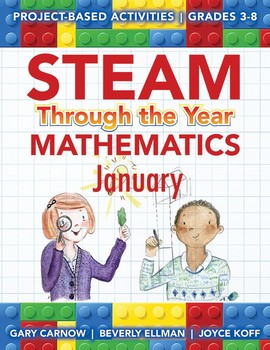STEAM Through the Year: Mathematics – January Edition
Inventive Thinkers
83 Followers
Grade Levels
1st - 6th, Homeschool, Not Grade Specific
Subjects
Resource Type
Standards
CCSS3.MD.A.2
CCSS5.NBT.A.2
CCSS3.OA.A.3
CCSS3.OA.D.8
CCSS3.NF.A.3b
Formats Included
- PDF
Pages
31 pages
Inventive Thinkers
83 Followers
Description
STEAM Through the Year: Mathematics for January guides you through the month with STEAM lessons and projects. Students build mathematical proficiency with monthly-thematic lessons correlated to the National Council of Teachers of Mathematics standards. Here you will find easy-to-use lessons providing practical strategies and problem-solving activities. The math and poetry lessons are themed around January special days and holidays – New Year’s Day, Celebration of Life Month, International Thank You Day and Martin Luther King, Jr. Day. Students gain access to the work of great poets by understanding and recognizing poetic forms. Need a creative STEAM math lesson idea? Simply turn to one of the selected days and you’re off and running. The math and poetry lessons are classroom-tested and provide enjoyable learning experiences in a variety of environments: traditional classrooms, home schooling, after-school programs, scouting, and gifted and talented programs. The resources and learning approaches are especially suited for gifted learners as they are inquiry-based and provide discovery learning opportunities with lots of higher-level questions. The activities also encourage student choice for independent or group work.
Total Pages
31 pages
Answer Key
N/A
Teaching Duration
N/A
Report this resource to TPT
Reported resources will be reviewed by our team. Report this resource to let us know if this resource violates TPT’s content guidelines.
Standards
to see state-specific standards (only available in the US).
CCSS3.MD.A.2
Measure and estimate liquid volumes and masses of objects using standard units of grams (g), kilograms (kg), and liters (l). Add, subtract, multiply, or divide to solve one-step word problems involving masses or volumes that are given in the same units, e.g., by using drawings (such as a beaker with a measurement scale) to represent the problem.
CCSS5.NBT.A.2
Explain patterns in the number of zeros of the product when multiplying a number by powers of 10, and explain patterns in the placement of the decimal point when a decimal is multiplied or divided by a power of 10. Use whole-number exponents to denote powers of 10.
CCSS3.OA.A.3
Use multiplication and division within 100 to solve word problems in situations involving equal groups, arrays, and measurement quantities, e.g., by using drawings and equations with a symbol for the unknown number to represent the problem.
CCSS3.OA.D.8
Solve two-step word problems using the four operations. Represent these problems using equations with a letter standing for the unknown quantity. Assess the reasonableness of answers using mental computation and estimation strategies including rounding.
CCSS3.NF.A.3b
Recognize and generate simple equivalent fractions, (e.g., 1/2 = 2/4, 4/6 = 2/3). Explain why the fractions are equivalent, e.g., by using a visual fraction model.





